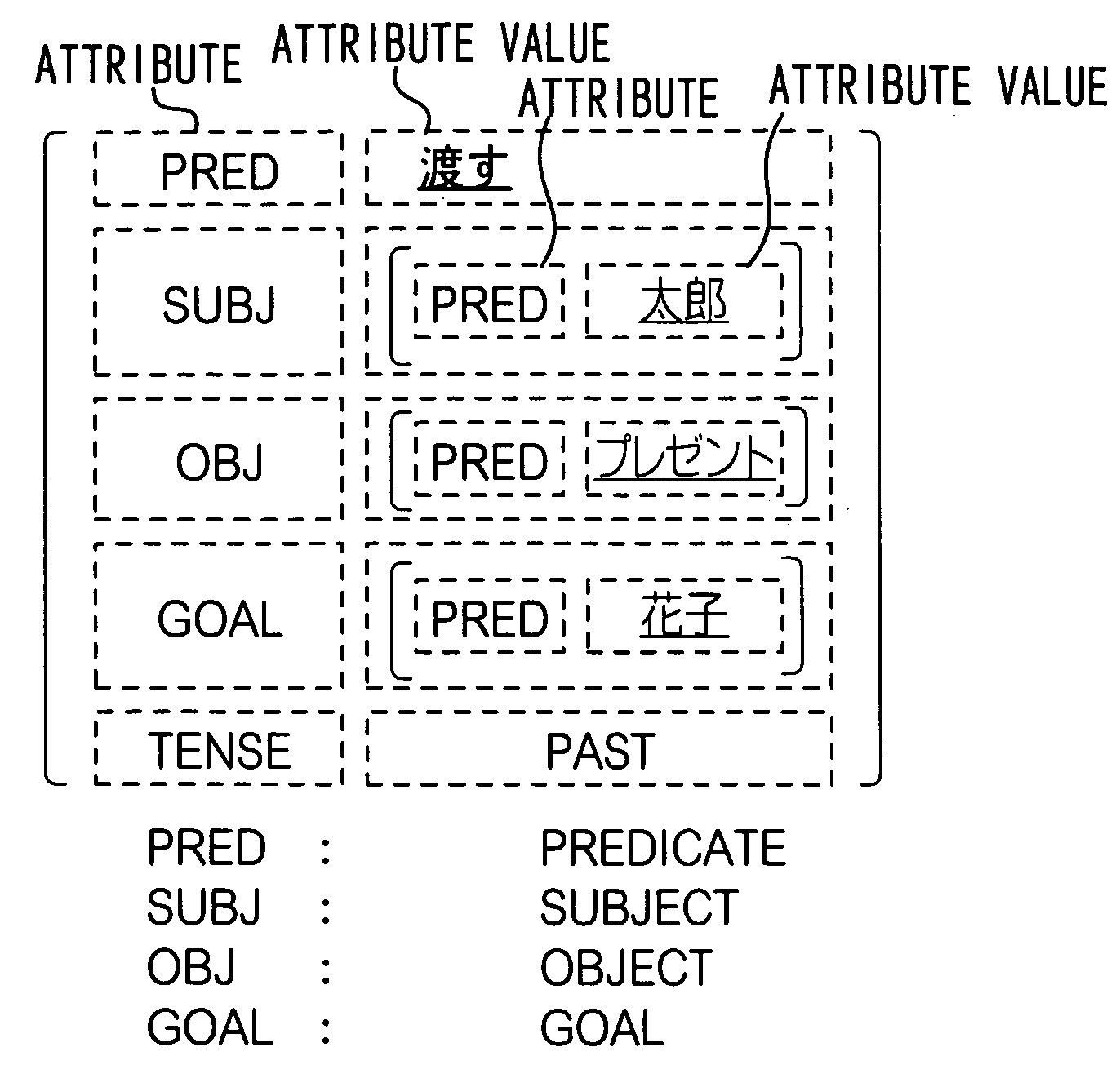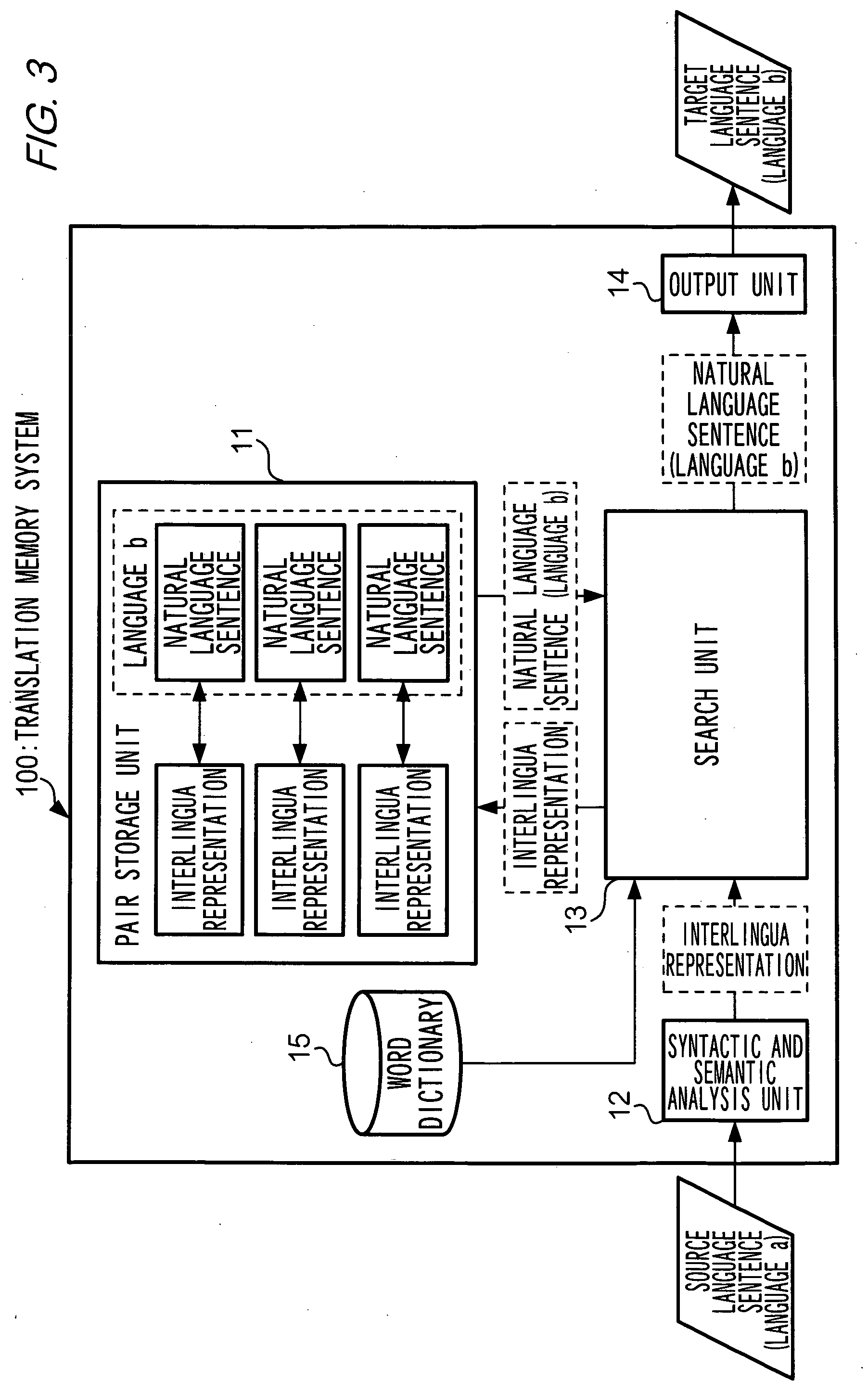Translation memory system
a memory system and translation technology, applied in the field of translation memory system, can solve the problems of enormous costs, time and effort required to prepare a set of bilingual pairs,
- Summary
- Abstract
- Description
- Claims
- Application Information
AI Technical Summary
Benefits of technology
Problems solved by technology
Method used
Image
Examples
first embodiment
1. First Embodiment
[0026] A translation memory system according to the present embodiment, instead of pre-storing bilingual pairs of natural language sentences as in the case of the related art, pre-stores bilingual pairs of an interlingua representation which is a representation by a non-language-specific interlingua and a natural language sentence, and makes a translation with reference to the bilingual pairs. The term “interlingua” refers to a meta-language (descriptive language) common to plural natural languages, and is designed to be interpreted by a computer. Such an interlingua has been proposed for use in several methods so far, and among the methods, there is an f-structure which is gained by an analysis based on a language analytic theory referred to as LFG (Lexical Functional Grammar). LFG is expounded in a publication: Miriam Butt, et al., “A Grammar Writer's Cookbook”, CSLI Publication (1999). The f-structure is characterized in that syntactic and semantic information ...
second embodiment
2. Second Embodiment
[0043] Pairs of an interlingua representation and a natural language sentence stored in pair storage unit 11 may be created manually, but the work takes much time and effort. However, according to the present embodiment described below, in a case where bilingual pairs of natural language sentences written in different languages have already been created, the bilingual pairs can be translated into pairs of an interlingua representation and a natural language sentence. Specifically, as shown in FIG. 6, a natural language sentence of a bilingual pair written in language 1 is subject to a syntactic and semantic analysis, and an interlingua representation of the natural language sentence is created on the basis of the analysis result, whereas a natural language sentence of the bilingual pair written in language 2 is subject to a syntactic and semantic analysis, and an interlingua representation of the natural language sentence is created on the basis of the analysis r...
third embodiment
3. Third Embodiment
[0055] The present embodiment is intended to provide a translation memory system which analyzes a “structure” of a source language sentence and enables translation of a part of the structure (hereinafter, referred to as a “partial structure”).
[0056] In a related art translation memory system, when a collection of bilingual pairs is searched for a natural language sentence which corresponds to or is similar to an input sentence, the similarity of the sentences is determined on the basis of only “surface information” of the sentences such as a notation and an order of words. Accordingly, if a long natural language sentence as described below is input into the translation memory system, it is highly unlikely that a target language sentence which corresponds to or is similar to the input sentence exists in a collection of bilingual pairs.
[0057]“The supreme court rendered a judgement that an abatement of a rent is allowed in a legal case where it is fought on the bas...
PUM
 Login to View More
Login to View More Abstract
Description
Claims
Application Information
 Login to View More
Login to View More - R&D
- Intellectual Property
- Life Sciences
- Materials
- Tech Scout
- Unparalleled Data Quality
- Higher Quality Content
- 60% Fewer Hallucinations
Browse by: Latest US Patents, China's latest patents, Technical Efficacy Thesaurus, Application Domain, Technology Topic, Popular Technical Reports.
© 2025 PatSnap. All rights reserved.Legal|Privacy policy|Modern Slavery Act Transparency Statement|Sitemap|About US| Contact US: help@patsnap.com



